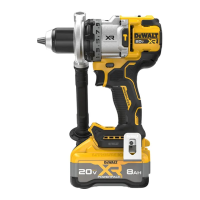14
ENGLISH
14
Performing an Application (Fig. A)
WARNING: To reduce the risk of personal injury,
ALWAYS ensure workpiece is anchored or clampedfirmly.
WARNING: Always wait until the motor has come to
a complete standstill before changing the direction
ofrotation.
Prior to Performing Work
• Set the speed selector
8
. Refer to SpeedSelection.
• Install the appropriate bit or accessory into the chuck. Refer
to Installing a Bit or Accessory into a KeylessChuck.
WARNING:
• Do not use this tool to mix or pump easily combustible
or explosive fluids (benzine, alcohol,etc.).
• Do not mix or stir flammable liquids
labeledaccordingly.
Screwdriving
Your tool has a clutch with adjustable torque for driving
and removing a wide array of fastener shapes and sizes. The
numbers 1–11 on the mode selection collar
5
are used to set
a torque range for screwdriving. The higher the number on the
collar, the higher the torque and the larger the fastener which
can bedriven.
1. Turn the mode selection collar
5
to the desiredposition.
Refer to Mode Selection.
2. Pull the trigger switch applying pressure in a straight line
with the bit until the fastener is seated at the desired depth
in theworkpiece.
Recommendations for Screwdriving
• Start with lower torque settings, then advance to higher
torque settings to avoid damage to the workpiece
orfastener.
• Make some practice runs in scrap or on unseen areas of the
workpiece to determine the proper position of the mode
selectioncollar.
Drilling
1. Turn the mode selection collar
5
to the drillsymbol. Refer
to ModeSelection.
2. Place drill bit in contact with theworkpiece.
NOTE: Use sharp drill bits only. For WOOD, use twist drill
bits, spade bits, auger bits, self‑feed bits, or hole saws. For
METAL, use twist drill bits, step bits, carbide hole cutters or
hole saws. Drill bits should be optimized for METAL cutting
with appropriate coatings and cuttingedges.
3. Pull the trigger switch applying pressure in a straight line
with the bit until it reaches the desireddepth.
WARNING: TO REDUCE THE RISK OF PERSONAL
INJURY, ALWAYS ensure workpiece is anchored or
clamped firmly. If drilling thin material, use a wood
“back‑up” block to prevent damage to thematerial.
4. Always apply pressure in a straight line with the bit. Use
enough pressure to keep drill biting, but do not push hard
enough to stall the motor or deflect thebit.
Pivoting LED Worklight (Fig. E, J)
The pivoting LED worklight
9
capsule is physically adjustable
via three detent positions. The pivoting LED worklight
9
and
the worklight button
10
are located on the foot of the tool.
The worklight is activated when the trigger is depressed. The
Off
19
, On
20
and 20minute modes
21
can be changed by
pressing the worklight button
10
on the foot of the tool. If the
trigger switch remains depressed, the worklight will remain on
in On and 20minutemodes.
When in the On setting, the beam will automatically turn off
20seconds after the trigger switch isreleased.
20 Minute Mode
The high setting is the 20minute mode
21
. The worklight
will run for 20minutes after the trigger switch is released. Two
minutes before the worklight will shut off, it will flash twice and
then dim. To avoid the worklight shutting off, lightly tap the
triggerswitch.
WARNING: While using the worklight in On or
20minute mode, do not stare at the light or place
the drill in a position which may cause anyone to
stare into the light. Serious eye injury couldresult.
CAUTION: When using the tool as a worklight, be sure
it is secured on a stable surface where it will not cause a
tripping or fallinghazard.
CAUTION: Remove all accessories from the chuck before
using the drill as a worklight. Personal injury or property
damage couldresult.
Variable Speed Trigger and Forward/Reverse
Control Button (Fig. A)
The tool is turned on and off by pulling and releasing the
variable speed trigger switch
3
. The farther the trigger switch
is depressed, the higher the speed of the tool. Your tool is
equipped with a brake. The chuck will stop as soon as the
trigger switch is fullyreleased.
A forward/reverse control button
4
determines the rotational
direction of the tool and also serves as a lock‑offbutton.
• To select forward rotation (clockwise), release the trigger
switch and depress the forward/reverse control button on
the right side of thetool.
• To select reverse (counterclockwise), depress the forward/
reverse control button on the left side of thetool.
NOTE: The center position of the control button locks the tool
in the off position. When changing the position of the control
button, be sure the trigger isreleased.
NOTE: Continuous use in variable speed range is not
recommended. It may damage the switch and should
beavoided.
NOTE: The first time the tool is run after changing the direction
of rotation, you may hear a click on start‑up. This is normal and
does not indicate aproblem.

